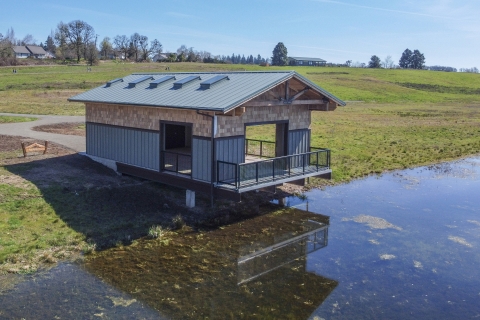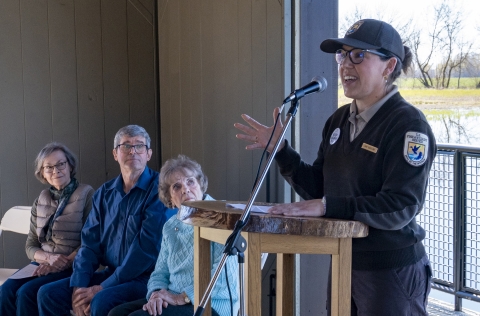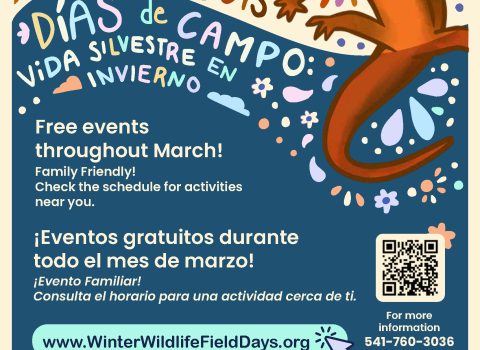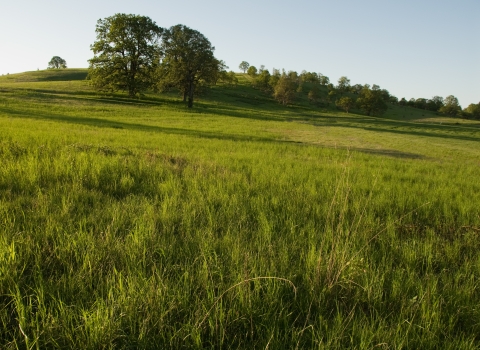The Willamette Valley is home to over 70% of Oregon’s population, including the most diverse and fastest growing cities. For over 10 years, Samantha Bartling has been working with the community to create welcoming and inclusive experiences for the Willamette Valley National Wildlife Refuge Complex. The three refuges that comprise the complex include William L. Finley near Corvallis and Ankeny and Baskett Slough near the state capitol, Salem. Established to prevent the potential extinction of dusky Canada geese and to protect native wildlife and plants, the refuges are strongholds for the rich wildlife and natural landscapes that define the valley.
In recognition of her work to create inclusive and welcoming opportunities for communities to engage with nature on their terms, Bartling has recently received the Secretary of the Interior’s Diversity Award. The award recognizes employees who have provided exemplary service and/or have made significant contributions to the department in its efforts to increase diversity at all levels.
The award citation read: “Ms. Bartling is a leader in environmental education within the U.S. Fish & Wildlife Service and the National Wildlife Refuge System, providing innovative and collaborative leadership to connect local communities with the Service’s mission in the Willamette Valley of Oregon. Ms. Bartling’s pioneering efforts connect people with nature and establish the Service as a community asset.
In 2015, Ms. Bartling created a Latino Engagement Program for the Willamette Valley where all materials and events are presented in at least two languages, English and Spanish. While bilingual herself, Ms. Bartling hires native-speaking bilingual interns to expand the Latino Engagement Program, ensuring inclusion across a broader public and fostering new relationships with the Spanish-speaking communities.
By partnering with a local non-profit environmental organization, Ms. Bartling realized a vision – the creation of the Ankeny Hill Nature Center – a gathering place where children and adults can discover the importance of the environment to our future. This facility, which opened to the public in 2022, provides indoor and outdoor classrooms, native oak prairie habitats, a pollinator garden and accessible trails that offer a diversity of educational opportunities and serves as an anchor for the community and the Service’s environmental education programs for the Willamette Valley. Ms. Bartling excels in connecting with the local communities and environmental educators to spread her enthusiasm for the Refuge, its wildlife, and the wetland and oak savanna habitats in the Willamette Valley. For one event, her efforts involved 30 partners and provided programming to 1,200 across three refuges and four counties in seven languages during an entire month. For her outstanding contributions to diversity in environmental education, connecting people with nature through a multitude of languages, sustaining partnerships, and being a community asset for the Service and the Nation, Samantha Bartling is granted the Secretary’s Diversity Award.
Finding time to sit down and talk with Bartling is no easy task, at any given time during the week she can be found hosting winter wildlife field days in urban parks, hosting programs for local schools at the Ankeny Hill Nature Center, coordinating volunteers, or hosting bilingual nature walks on popular refuge trails. I was able to get a few minutes of her time to learn more about her vision for community engagement with conservation, national wildlife refuges, and their natural world.
Q: Where does your passion for inclusive conservation come from?
A: My first job was working in Alaska and closely with native villages. I was given a Yup’ik name and the whole experience changed me and my life. From there my dream of being a refuge manager shifted and I wanted to be a leader/manager that worked with the community to care for the refuge and along the way it has shifted some more. I want to help create and support a team of people who are empowered to be themselves and to do the work they love in the creative and special ways they are inspired and moved to do so. When wildlife thrives, people thrive. We need each other and it’s a beautiful circle. Twenty years ago I wrote “Making space(s) for wildlife y TODOS” on a piece of paper with smelly markers – and a version of that poster has hung on my office wall ever since. It’s a professional and personal touchstone and north star for me. It’s my mission to make space(s) for wildlife and to make space(s) for everyone.
Q: What do you want visitors to feel when they come to a refuge in the Willamette Valley?
A: I want them to feel safe first and foremost; and that they belong and are “home.” A little sense of pride and ownership, too! I hope people feel comfortable doing nature how they want to – whatever that looks like for them. Refuges are perfect for an up close and special wildlife encounters. I want people to have those memory making opportunities!
Q: What accessible opportunities are there for visitors to the Willamette Valley National Wildlife Refuge Complex?
A: We have a lot of layers of accessible opportunities, which is part of the experiences we want to provide. Accessibility if not just the physical spaces, but should also be thought of virtually, culturally, through language and for programs and materials.
The Ankeny Hill Nature Center has an accessibility icon built-in so that you can experience the website with large letters, dyslexia-friendly font, whatever contrast you chose, including language. Everything is universal or in Spanish and English for programs and signage, etc.
If you want to skip a walk, we have accessible picnic tables at all of our major gathering areas. Want to stay in your car? It is the perfect rolling wildlife blind! We have marshes along the roads with logs placed close-in for better viewing and photography options. There are accessible trails at both Ankeny and William L. Finley refuges and bilingual discovery elements as well!
Q: Can you tell me about the Winter Wildlife Field Days that take place around the Willamette Valley?
A: I hope folks can participate if they haven’t already! Winter Wildlife Field Days stared as a one-day event at just William L. Finley NWR 10 years ago. Soon it became fully bilingual. Then we got transportation from the local bilingual schools out to the refuge. We often had over 800 people at William L. Finley refuge at each event. When Covid hit we took it as an opportunity to do things differently and to really and truly make it as accessible and as inclusive as we could. We started holding the event at multiple places throughout the community throughout the entire month of March, transportation was no longer needed because we are meeting people where they already are. We put bilingual and accessible activities on the website and bilingual field guides in self-guided stations in city parks and nearby schools. We try to have activities for all learning styles. This year we worked with thirty-five partners to host nineteen events across nine cities in the Willamette Valley.
If you live far away or it’s hard for you physically get to one of the in-person events, then just head to the event website for bilingual activities and take-home kits: http://www.winterwildlifefielddays.org.
Q: As the population grows in the Willamette Valley, what do you see as the future for environmental education at the refuge complex?
A: No matter what the population number is, it’s about reaching beyond our traditional audiences and trying to reach more of our community. We need to meet people where they are – physically and culturally. Nature experiences and environmental education can happen anywhere: in city parks, in school playgrounds, and at a local wildlife refuge. Small and big scales both matter in conservation and environmental education.
Todos son Bienvenidos. Everyone Belongs Here. I put this message everywhere: at the refuges and events, in displays and interpretive table. For those that need to see and feel that message, it will mean so much. They will likely come back and will let their friends and family know about the neat place they just visited.
Try new things! Do things differently! You never know where you might make a new connection for someone.
Q: What do you love most about working with your community?
A: The connections I make and the people! It’s those moments and memories you can feel and cannot forget. My community and the friends I’ve made along the way are my found family.







